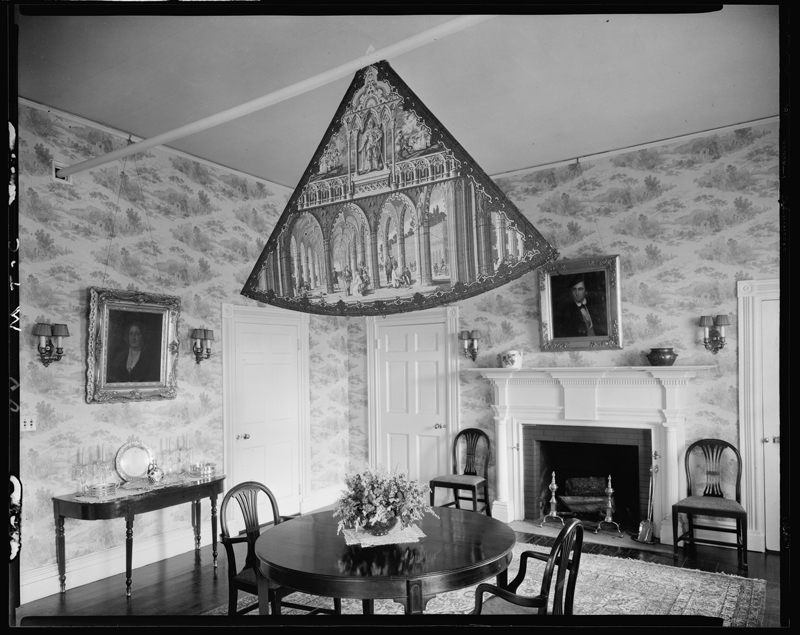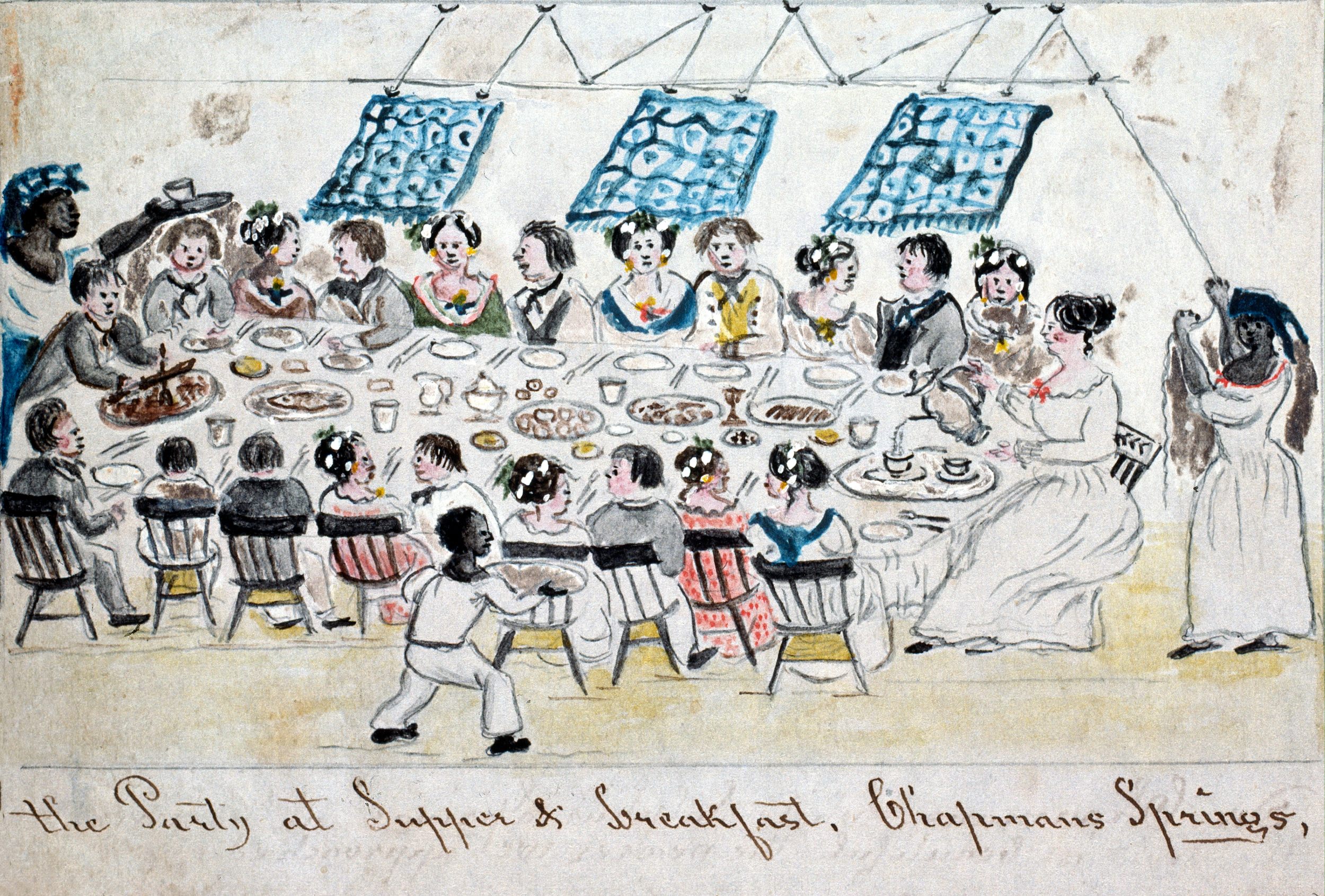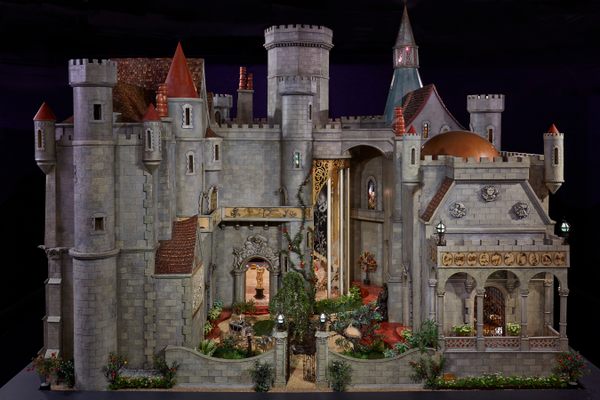How Ceiling Fans Allowed Slaves to Eavesdrop on Plantation Owners
The punkahs of the Antebellum era served many purposes.

In the mid 19th century, slaves throughout the American South pulled at ropes and chains nonstop during summer mealtimes, to make plantation dining rooms bearable in beastly humid heat. The slaves would swing wooden panels or fringed fabric rectangles that were mounted on the dining room ceilings. The arduous labor created breezes and flicked insects away from the food and the guests’ flesh. The fans were called punkahs—the same name was applied to their counterparts in India, which servants waved above British colonists.
For American slaveholders, assigning people (usually boys and men dressed in brown and red livery) to work the punkah cords during parties was a way to flaunt wealth. Dana E. Byrd, a Bowdoin College scholar who has studied plantation life, said that the public display “would have undoubtedly been regarded as an extravagant use of labor.” She also notes that there were some benefits to the work. The fanners could listen to party conversations, which sometimes revealed useful or important news, about owners who might soon auction their enslaved families, abolitionists growing active in the region, and slaves managing to revolt or escape.


Dr. Byrd’s website, The Punkah Project, describes about 40 examples of the fans that have been mentioned in documents or surfaced at institutions, homes, auction houses, hotels, and events spaces. The website maps their locations, from Connecticut to Florida. They can be as humble as an unpainted plank, at Kent Plantation House in Alexandria, Louisiana, and as intricately patterned as a triangular board covered with wallpaper depicting European colonnades, at Tallwood plantation near Charlottesville, Virginia.
Many of them, including a scrollwork mahogany slab at Melrose mansion in Natchez, Mississippi, seem to have been designed to look particularly weighty, so that visitors understood the effort required of the operators. Dr. Byrd occasionally learns about a previously unknown example; a rough wooden triangle is set on the dining room ceiling of Kleinpeter House in Baton Rouge, a newly restored structure built in 1820 for Alsatian-American farmers.
At least one famous antebellum homeowner, Thomas Jefferson, did tinker around with concepts for equipment that would have spared his workers from punkah duty. Around 1804, he filled a notebook page with proposed ideas for gears and pendulums that could power a ceiling fan in the dining room at Monticello. He predicted that it would “run an hour” before it required rewinding. Dr. Byrd has found no evidence that the machine was ever prototyped or installed.

After the Civil War, freed slaves recorded what they had endured during fanning duty, in autobiographies and interviews with historians. Booker T. Washington’s 1901 memoir describes how much he had learned in the 1860s by eavesdropping about “the subject of freedom and the war,” while he was a child enslaved in Virginia and powering his owners’ punkahs. Neal Upson, a former slave who lived in Athens, Georgia, recalled in the 1930s that his owner had whipped him when he faltered during a fanning stint. Henry Coleman, who had been born into slavery on a South Carolina plantation, had been hoisted into an overhead swing to operate the dining room’s fanning mechanism. In the 1930s, Mr. Coleman told an interviewer that when he fell asleep on the swing, his master would wake him, and the dinner guests teased him for being “so lazy.”
Dr. Byrd says that Mr. Coleman’s experience can nonetheless be interpreted somewhat poetically. “Though still at his owner’s beck and call, he was positioned above the fray,” she writes in a 2016 essay. The swing allowed him a little power, “something close to flight and a fleeting feeling of freedom.”

In the early 20th century, as plantations were adapted into house museums, scholars began documenting the punkahs. Their writings scarcely mentioned the objects’ underlying cruelty. Dr. Byrd points out that the authors sometimes even used passive language to describe how the devices functioned—as if no humans were at the controls. Mary Willis Shuey, a writer in Shreveport, Louisiana, told The Magazine Antiques in 1935 that punkahs amounted to “an ingenious arrangement by which the air was kept in motion and the impertinent advances of flies and mosquitoes were discouraged.”
Antique punkahs occasionally appear on the market, and they can sell for thousands of dollars each. One frequent buyer is John Cummings, the founder of the Whitney Plantation, a museum and memorial to slaves near New Orleans. He has acquired five punkahs so far, and he has pored over interviews with the slaves who pulled the ropes and longed for the dinner parties to end. He will not be installing the fans in his property’s main house. The ceilings are too low, he says—the rooms probably did not have punkahs originally. He is more interested, he adds, in documenting slaves’ meager possessions rather than displaying slaveholders’ elaborate furnishings.

Findowrie, a plantation house that a Revolutionary War soldier built in 1782 near Charlottesville, retains ghosts of its original punkah; the dining room ceiling has wrought iron hooks a few feet apart. The property was recently sold to Tim Mullins, a bank executive who plans to research and restore it. The antebellum owners prospered by quarrying stone, running a steam-powered sawmill that supplied railroad ties, and making hard cider (Thomas Jefferson was a repeat customer). Mr. Mullins has found two names so far of the dozens of people enslaved there: Grace and Sara. The site contains ruins and foundations of outbuildings, including a blacksmithing workshop, a corn crib and slave quarters. There is a family cemetery for the owners; slaves likely had a separate graveyard nearby, with markers made of plain fieldstones.
Findowrie’s punkah was probably a fan-shaped panel, made of southern yellow pine that was milled onsite. Mr. Mullins plans to commission a replica. It will serve as a kind of shrine to the plantation’s enslaved people. It will be operable, as befits a historically accurate restoration, but not needed. The house, Mr. Mullins says, “will hopefully have air conditioning.”
































Follow us on Twitter to get the latest on the world's hidden wonders.
Like us on Facebook to get the latest on the world's hidden wonders.
Follow us on Twitter Like us on Facebook